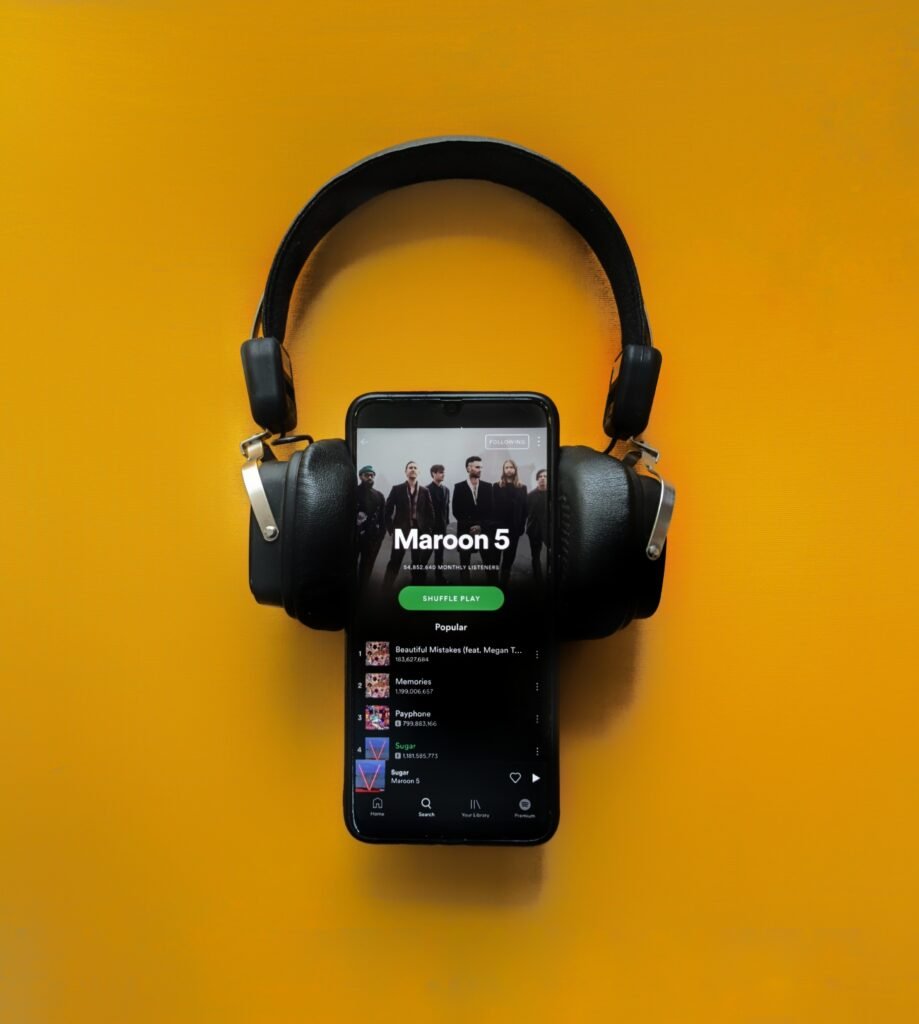Imagine a world where you have access to millions of songs at your fingertips, anytime and anywhere. No more bulky CDs, no more searching for your favorite album in a record store. This is the power of Spotify, the music streaming platform that is revolutionizing the way we listen to music. With its vast library of tracks, personalized playlists, and innovative features, Spotify is redefining the music industry and shaping the future of how we enjoy our favorite tunes. In this article, we will explore how Spotify has become a game-changer in the world of music streaming.

Introduction
In the rapidly evolving music industry, Spotify has emerged as a trailblazer in the realm of streaming services. With its user-friendly interface, extensive music library, and personalized recommendations, Spotify has not only transformed the way we consume music but has also had a profound impact on the industry as a whole. This article will delve into the rise of Spotify, the impact it has had on the music industry, its advantages over competitors, its business model and future expansion plans, as well as the challenges that lie ahead.
1. The Rise of Spotify
1.1 Early Beginnings
Spotify’s origin story dates back to 2006 when Daniel Ek and Martin Lorentzon, two ambitious entrepreneurs from Sweden, recognized the potential of streaming as a dominant method of music consumption. They launched Spotify in 2008, introducing a freemium model that allowed users to access a limited music library with occasional advertisements. This early iteration laid the foundation for what would become a music streaming powerhouse.
1.2 Expansion and Global Dominance
After gaining popularity in European markets, Spotify made its way across the Atlantic to the United States in 2011. This move marked a turning point for the company, as it quickly gained millions of users and established partnerships with major record labels. In subsequent years, Spotify expanded its reach worldwide, solidifying its position as the leading streaming service with millions of active users.
1.3 Challenges and Competition
While Spotify soared to the top of the streaming industry, it faced challenges along the way. One of the major obstacles was negotiating licensing agreements with record labels, as the existing music industry infrastructure was wary of the digital disruption caused by streaming services. Additionally, Spotify faced fierce competition from other streaming platforms like Apple Music and Amazon Music, which intensified the battle for market share and pushed Spotify to constantly innovate and improve its offering.
2. The Impact on the Music Industry
2.1 Changing Revenue Models
Spotify’s disruptive entry into the music industry has fundamentally altered the way artists and labels generate revenue. With the decline of physical album sales and the rise of streaming, artists have had to adapt to new revenue models centered around streaming payouts. While some artists have voiced concerns over the perceived unfair compensation, the streaming model has also opened up opportunities for independent artists to reach wider audiences and earn a living through their craft.
2.2 Negotiations with Artists and Labels
As Spotify grew in popularity, it became a crucial platform for artists to showcase their work. This led to a shift in the power dynamics between music labels and streaming services, with artists leveraging their popularity and demand to negotiate more favorable deals. Through these negotiations, Spotify introduced features such as windowed releases, allowing artists to restrict their music’s availability to certain subscription tiers, granting them more control over their content’s distribution and release strategy.
2.3 Music Discovery and Exposure
One of the key benefits of Spotify for artists is the ability to reach a vast global audience. By providing listeners with personalized recommendations and curated playlists, Spotify has become a go-to platform for music discovery. This exposure has helped emerging artists gain traction and has revitalized the careers of established musicians, ensuring that their music reaches an engaged and diverse audience.
2.4 Engaging with Fans
Spotify’s integration of social features has revolutionized how artists connect with their fanbase. Through artist profiles and the ability to follow favorite musicians, fans can stay updated on their latest releases, concerts, and personal updates. Additionally, Spotify’s algorithm-driven playlists like “Release Radar” and “Discover Weekly” keep fans hooked by continually delivering new music tailored to their preferences, fostering a sense of loyalty and engagement with the artists they love.
2.5 Concert and Tour Promotion
Spotify’s influence extends beyond the virtual realm of music streaming. By partnering with ticketing platforms and integrating concert listings, Spotify has become a powerful tool for artists to promote their live shows. When a user follows an artist on Spotify, they receive notifications about upcoming concerts in their area, allowing artists to tap into a dedicated fan base and drive ticket sales to their shows.
3. The Advantages of Spotify
3.1 Huge Music Library
One of Spotify’s greatest strengths is its extensive music library, housing millions of songs across various genres. From classic hits to independent releases, users can access a diverse range of tracks, ensuring that there is something for everyone’s taste. The ever-expanding library fosters discovery and provides a platform for both established and emerging artists to showcase their music.
3.2 Personalized Recommendations
At the heart of Spotify’s user experience is its personalized recommendation algorithm. By analyzing user listening habits and preferences, Spotify delivers customized playlists such as “Discover Weekly” and “Daily Mixes” that introduce users to new artists and songs tailored to their tastes. This personalized approach enhances the overall user experience by creating a sense of discovery and anticipation for new music.
3.3 Social Sharing and Collaborative Playlists
Spotify’s social features allow users to share their favorite songs, playlists, and even what they’re currently listening to with friends and followers. This social sharing not only promotes music discovery but also fosters a sense of community among users. Additionally, Spotify allows users to collaborate on playlists, enabling friends to curate and contribute to a shared musical experience.
3.4 User-Friendly Interface
Spotify’s user-friendly interface has been integral to its success. The platform’s intuitive design allows users to navigate effortlessly through the extensive music library, playlists, and artist profiles. With features like drag-and-drop playlist creation and easy search functionality, Spotify ensures a seamless and enjoyable user experience.
3.5 Cross-Platform Accessibility
Spotify’s commitment to cross-platform accessibility has made it a ubiquitous presence in users’ lives. Whether on smartphones, tablets, computers, or even smart speakers, Spotify is available on a wide range of devices and operating systems. This accessibility enables users to seamlessly transition between devices and enjoy their favorite music wherever they go.

4. Business Model and Expansion
4.1 Freemium vs. Premium Subscriptions
Spotify’s freemium model, with its ad-supported free tier, has been a pivotal factor in its mass adoption and growth. While the free version offers limited features and occasional ads, it serves as a crucial entry point for users. To unlock extra features, remove ads, and gain access to exclusive content, users can opt for premium subscriptions, which generate revenue for Spotify.
4.2 Advertising Revenue
In addition to premium subscriptions, Spotify generates revenue through advertising. By partnering with brands and advertisers, Spotify offers targeted and personalized ad campaigns within its platform. These ads range from audio advertisements to sponsored playlists, providing advertisers with a unique opportunity to reach a highly engaged audience while simultaneously supporting the platform financially.
4.3 Podcasting Growth
Recognizing the growing popularity of podcasts, Spotify has made significant investments in podcasting, both in terms of acquisitions and original content. By expanding its podcast offerings and securing exclusive deals with popular podcasters, Spotify aims to further diversify its content library and attract new users who are drawn to the wide array of audio entertainment options beyond music.
4.4 International Expansion
While Spotify has firmly established itself in many markets around the world, it continues to seek opportunities for international expansion. By tailoring its offerings to the specific needs and preferences of different regions, Spotify aims to solidify its presence in untapped markets and reach a wider global audience.
5. The Future of Streaming
5.1 Artificial Intelligence and Machine Learning
As technology progresses, artificial intelligence and machine learning will play an increasingly significant role in music streaming. By analyzing vast amounts of data, AI can personalize recommendations even further and help users discover music based on various factors, such as mood, location, and time of day. This level of personalization will enhance the overall user experience and keep listeners engaged.
5.2 Virtual Reality and Enhanced Immersion
As virtual reality technology evolves, it has the potential to revolutionize the way we interact with music. Imagine attending a virtual concert from the comfort of your own home or experiencing music in a fully immersive environment. Spotify could explore partnerships with virtual reality platforms to offer unique and immersive music experiences, further blurring the lines between reality and virtuality.
5.3 Integration with Smart Devices
With the rise of smart devices, Spotify has the opportunity to further integrate itself into users’ daily lives. By partnering with manufacturers of smart speakers, cars, and other connected devices, Spotify can seamlessly integrate its service into these devices, making music even more easily accessible and improving the overall streaming experience.
5.4 Increased Emphasis on Localization
As music consumption becomes increasingly global, there is a growing demand for localized content. Spotify has already begun catering to this demand by curating playlists and spotlighting regional artists in specific countries. Moving forward, the platform could continue to prioritize localization efforts, becoming a gateway for users to discover new music from around the world while preserving and promoting diverse music cultures.

This image is property of images.unsplash.com.
6. The Challenges Ahead
6.1 Content Licensing and Royalty Payments
One of the ongoing challenges for Spotify is navigating the complex landscape of content licensing and royalty payments. As the streaming industry matures, negotiations with artists, labels, and publishers will continue to be a delicate balancing act, ensuring fair compensation for creators while maintaining a sustainable business model for Spotify.
6.2 Balancing User Experience with Artist Compensation
As Spotify fine-tunes its algorithms and personalization features, it must strike a delicate balance between prioritizing user experience and ensuring fair compensation for artists. While personalized recommendations and curated playlists are crucial for user engagement, efforts must also be made to ensure that artists receive adequate compensation for their work and are not disproportionately affected by streaming revenue models.
6.3 Competition from Other Streaming Services
Spotify operates in a highly competitive landscape, with rival streaming services vying for market share. In order to stay ahead, Spotify must continue to innovate and differentiate itself from the competition by offering unique features, exploring new content formats, and building strong relationships with artists and labels.
6.4 Addressing Copyright Infringement
Despite efforts to crack down on copyright infringement, Spotify, like other streaming platforms, faces the challenge of identifying and removing unauthorized content from its library. By investing in robust content identification technologies and refining its content moderation processes, Spotify can continue to protect the rights of creators and provide a secure and trustworthy platform for users.
6.5 Maintaining User Trust and Privacy
As a platform that collects vast amounts of data on user listening habits, Spotify must prioritize user trust and privacy. By implementing stringent data protection measures, being transparent and accountable with data usage, and continuously improving privacy features, Spotify can ensure that users feel confident in entrusting their personal information to the platform.
7. Conclusion
Spotify has undeniably revolutionized the way we listen to and discover music. With its extensive music library, personalized recommendations, and social features, Spotify has created an engaging and immersive streaming experience for millions of users worldwide. However, the challenges ahead, such as content licensing, artist compensation, and competition, will test Spotify’s ability to maintain its dominance. By embracing emerging technologies, refining its business model, and addressing industry challenges head-on, Spotify is poised to shape the future of music streaming and continue pushing boundaries in the ever-evolving landscape of the music industry.

This image is property of images.unsplash.com.



